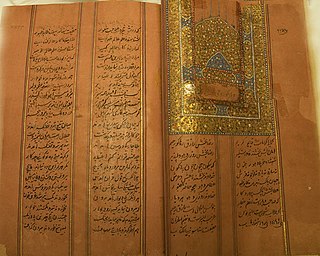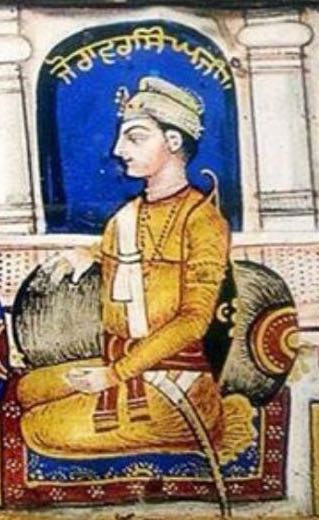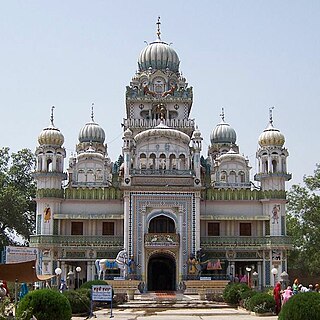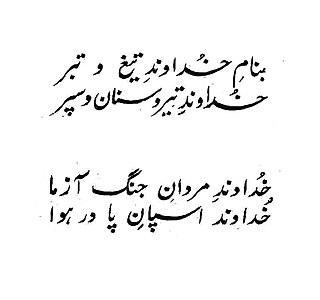
Guru Gobind Singh was the tenth and last human Sikh Guru. He was a warrior, poet, and philosopher. In 1675, at the age of nine he was formally installed as the leader of the Sikhs after his father Guru Tegh Bahadur was executed by Emperor Aurangzeb. His father was the ninth Sikh Guru. His four biological sons died during his lifetime – two in battle and two executed by the Mughal governor Wazir Khan.
The following outline is provides an overview of Sikhism, or Sikhi.

The Dasam Granth is a collection of various poetic compositions attributed to Guru Gobind Singh. The text enjoyed an equal status with the Adi Granth, or Guru Granth Sahib, in the eighteenth and nineteenth centuries and were installed side by side on the same platform. The Dasam Granth lost favor during the colonial period when reformist Singh Sabha Movement scholars couldn't contextualize the reworkings of Puranic stories or the vast collection of 'Tales of Deceit' Sri Charitropakhyan.

The Zafarnāma was a spiritual victory letter sent by Guru Gobind Singh in 1705 to the Mughal Emperor of India, Aurangzeb, after the Battle of Chamkaur.

Anandpur Sahib, also referred simply as Anandpur, is a city in Rupnagar district (Ropar), on the edge of Shivalik Hills, in the Indian state of Punjab. Located near the Sutlej River, the city is one of the most sacred religious places in Sikhism, being the place where the last two Sikh Gurus, Guru Tegh Bahadur and Guru Gobind Singh, lived. It is also the place where Guru Gobind Singh founded the Khalsa Panth in 1699. The city is home to Takhat Sri Kesgarh Sahib, the third of the five Takhts in Sikhism.
Dharam Singh Dalal, born as Dharam Das, was one of the original Panj Pyare or the Five Beloved, the forerunners of the Khalsa.
Daya Singh was one of the Panj Pyare, the first five Sikhs to be initiated into the Khalsa order in 17th-century India.
Bhai Himmat Singh (1661–1705), born Himmat Rai, was one of the inaugural group of Panj Pyare, or the first group of the Five Beloved in Sikhism.

Zorawar Singh, alternatively spelt as Jorawar Singh, was a son of Guru Gobind Singh who was executed in the court of Wazir Khan, the Mughal Governor of Sirhind.

Fateh Singh, commonly referred to with honorifics as Baba Fateh Singh or Sahibzada Baba Fateh Singh, was the fourth and youngest son of Guru Gobind Singh.
Machhiwara is one of the developing cities in the Ludhiana district of the Indian state of Punjab. Machhiwara is famous for Gurudwara Sri Charan Kanwal Sahib associated with Guru Gobind Singh ji and named after the Guru's feet that are compared to the lotus flower. And It is also famous for Religious Hindu Sri Shivala Bramchari Temple associated with the Pandavas of Dvapara Yuga.
Zafarnama is the title of a number of Persian and Turkish literary works

Mai Bhago also known as Mata Bhag Kaur, was a Sikh woman who led Sikh soldiers against the Mughals in 1705. She was an exceptionally skilled warrior on the battlefield and is revered as a warrior saint in Sikhism. She was known for rallying the 40 Sikhs who abandoned Guru Gobind Singh at the siege of Anandpur Sahib and bringing them back to fight.

The Saka Sirhindor the Chhotte Sahibzada Saka refers to the killing and martyrdom (Shaheedi) of the two sons of Guru Gobind Singh, named Zorawar Singh and Fateh Singh. The two Sikh children are remembered as the Chhotte Sahibzade. They are believed to have attained martyrdom on 26 December 1704 at the ages of 5(or 6) and 9 respectively. In remembrance of this occasion, the Shaheedi Jor Mela is organised annually at Fatehgarh Sahib Punjab, India, to commemorate the supreme sacrifice at the place of their martyrdom on the 24th to 26 December.

Gurdwara Mehdiana Sahib, also called the 'School of Sikh History' is a Sikh gurdwara located in the village of Mehdiana, just outside Mallha, near Jagraon in Ludhiana district, India.

Hikaaitaan or Hikāyatān is a title given to the semi-legendary set of 11 tales, composed in the Gurmukhi/Persian vernacular, whose authorship is traditionally attributed to Guru Gobind Singh. It is the last composition of the second scripture of Sikhs, Dasam Granth, and some believe it to be appended to Zafarnamah—the letter to Mughal emperor Aurangzeb.

The Battle of Sarsa was fought in 21 December 1704 between the Khalsa and the Mughal Empire.
The First Battle of Anandpur in 1704 was fought between the Mughal Empire and the Sikhs.

Fatehnama, also known as Namah-i-Guru Gobind Singh or the Jangnamah is a Persian composition attributed to Guru Gobind Singh. It was contained within the Dasam Granth.












